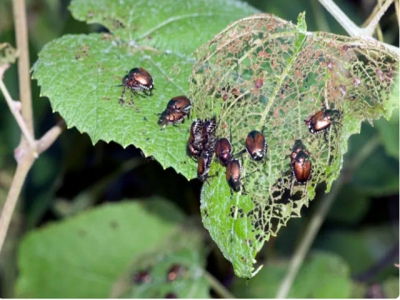The Japanese Beetles Are Back

Back without popular demand: Here comes the annual showing of Japanese beetles, the embodiment of beauty and the beast rolled into one.
Japanese beetle eat trees in Illinois. Photo: NYT
The 4-6-week period of intense activity by the gleaming, copper-colored adult Popillia japonica is underway.
These beetles may seem to have it in specifically for your roses, raspberries, crab apples or grapes, but those are just a few of the 300-plus plant species they are known to feed on in North America.
The expert advice might sound counterintuitive: Stop trapping them. (Farewell, beetle bags, despite the marketing promises.) And maybe hold back on watering lawns in the July heat, as female beetles will be seeking a moist spot to lay eggs.
Yes, those are steps toward making peace with this here-to-stay invasive pest, which scientists have sought to subdue since shortly after it was identified in New Jersey in 1916.
Nearly a century later, a 2015 U.S. Department of Agriculture homeowners’ guide to Japanese beetle management put the cost of control in the United States — including the removal and replacement of damaged turf — at $460 million annually. Half of that damage is caused not by the adults, but during the beetles’ larval stage, by the grubs.
Still, this is a troublemaker at both stages of life — and its wide-ranging diet doesn’t hurt its chances, either.
Based on decades of tracking the beetles’ seemingly inexorable march westward in North America, Daniel A. Potter, a professor in the department of entomology at University of Kentucky, described the arc: “The first few decades in a new area, the insect goes crazy and builds to high levels before the population starts to stabilize. Then it goes from a plague to a nuisance.”
For those of us at the nuisance phase, here are some suggestions. But first, some background on the strategies behind the Japanese beetle’s sustained invasion.
Related news
 Central Highlands’ largest fruit, vegetable processing centre opened
Central Highlands’ largest fruit, vegetable processing centre opened The largest fruit and vegetable processing centre of the Central Highlands was inaugurated in Gia Lai province on September 9.
 Vietnam’s fresh longan makes debut in Australia
Vietnam’s fresh longan makes debut in Australia In nearly one hour after hitting the shelves, more than 500kg of imported fresh longan were sold to retailers.
 Cassava exports face fierce competition from Thailand
Cassava exports face fierce competition from Thailand It is forecast that in the last months of this year, exports of cassava and cassava products from Vietnam to China will face fierce competition from Thailand
 US cherries, lobster best-sellers in Vietnam
US cherries, lobster best-sellers in Vietnam Economists attribute the increase in US imports to lower prices and US-China trade tension that have forced US exporters to seek other markets instead of China.
 Global glut pushes down Vietnam’s coffee export earnings
Global glut pushes down Vietnam’s coffee export earnings Since early this year, coffee prices have dropped in both foreign and domestic markets, and no significant change is forecast as the world’s leading coffee